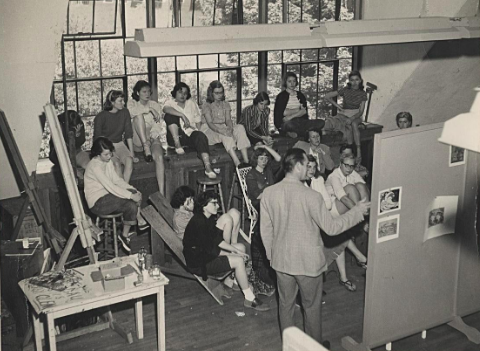Bennington Art Policy
Originally written for Bennington College by Paul Feeley, October, 1959
I have written my notes with respect to policy under the heading of aims. In many cases these aims represent present purposes; in others, they represent notions the art faculty have discussed and may discuss further. These aims are listed below:
Increased faculty common understanding so that students may be reassured and encouraged at meeting a façade of belief and conviction.
An increased number of projects and offerings that emphasize the importance of general human views.
A valiant attempt to define the 20th century so that we may know what we are working with.
The encouragement to do the most elementary and primitive things in art, if necessary, in order not to operate in a hollow, pretentious manner.
A willingness at all times to return to first principles, to get back to simple things in order not to get lost in complex uncertainties.
Increased understanding of past and present culture.
Increased integration of the visual arts with other ways in which man represents his insights and visions both individually and communally.
To encourage the desire to ask questions which make it clear that any assumption about art is an assumption about life.
To be challenged by the opportunity of finding life relationships in the rare arena where form is confronted by the word, and not to answer that challenge by an art school formula.
To view the study of art in the light of making living worthwhile and not simply in the light of encouraging a talented few.
To encourage the achievement of some philosophic position in the visual arts which can give people the human satisfaction of aiming for something—or going somewhere. Such a philosophic position is implied by a willingness to start all over again, that is, to see what one can do about doing a simple thing well. Some of these Wagnerian aims do nothing but disgust and frustrate one.
To increase all the studies implied by the word Art rather than the divistionistic sense raised by the pursuits that come under the different headings of art—painting, sculpture, graphic arts, etc.
To give specific thought to what it means to study art in our time. Clearly we are responding to world conditions that have never been quite this way before.
On the grounds that self-expression is too lonesome, to encourage all corporate enterprises in the visual arts.
To be unafraid of the lack of apparent absolutism in the visual arts—rather, to preserve the sense that anyone can make a mark.
To recognize the necessity felt by the individual to make his own mark and lead toward more corporate enterprises after recognizing that necessity.
To place the study of art at the level of the study of poetry. This will make the nature of our commitment clear.
To encourage contemplation and reflection as sources of human action; however, not to deny the creative power of impulsiveness and spontaneity.
To train people to read art as an expression of human ideas.
To emphasize the notion of the study of art as a way of leading to a way of life, not the study of art as the acquisition of a vocational technique leading to immediate success.
